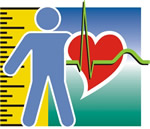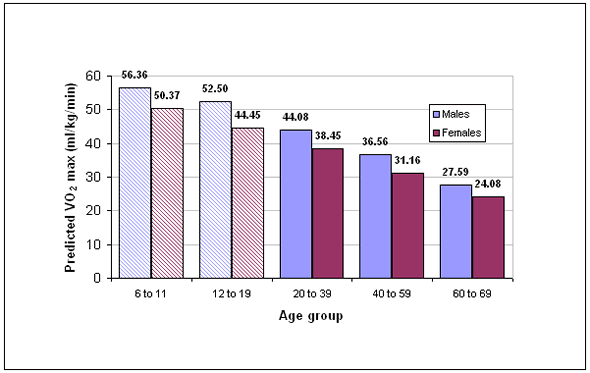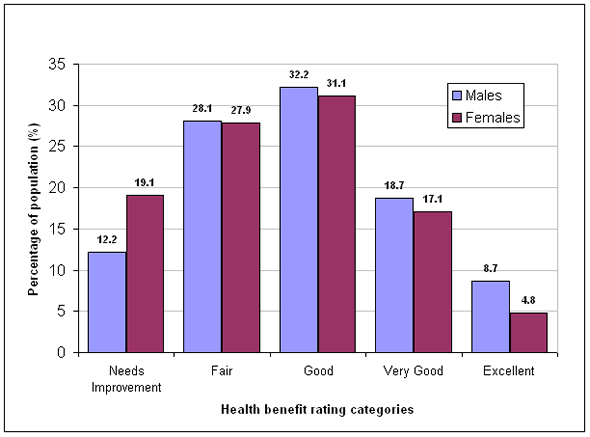Aerobic fitness in Canada 2007 to 2009
Archived Content
Information identified as archived is provided for reference, research or recordkeeping purposes. It is not subject to the Government of Canada Web Standards and has not been altered or updated since it was archived. Please "contact us" to request a format other than those available.

Predicted maximal aerobic power (in millilitres per kilogram of body weight per minute, or mL/kg/min) is an estimate of the maximum volume of oxygen an individual can utilize per minute of exercise relative to their body weight.
Predicted maximal aerobic power (VO2 max) is higher in males across all age groups indicating that males have better aerobic fitness levels than females at all ages.
The VO2 max declines with age in both men and women. In children, the aerobic fitness levels fall from 56.4 mL/kg/min to 52.5 mL/kg/min in boys and from 50.4 mL/kg/min to 44.5 mL/kg/min in girls for the 6 to 11 year and 12 to 19 year age groups respectively.
Chart 1
Aerobic fitness of Canadian children and adults, by age group and sex

Note: The equation for predicted VO2 max has not been validated for children aged 6 to 14; so, bars on the graph for age groups containing these children are shaded
Source: Canadian Health Measures Survey, 2007 to 2009
Similarly, in adults, the predicted VO2 max falls from 44.1 mL/kg/min to 27.6 mL/kg/min in men and from 38.4 mL/kg/min to 24.1 mL/kg/min in women for the 20 to 39 year and 60 to 69 year age groups respectively.
Aerobic fitness ratings
In Canada, 31.1% of women aged 15 to 69 and 32.2% of men were categorized as having a "Good" health benefit rating. This category represents the largest proportion of Canadian adults. When looking at both ends of the spectrum, more adults have a "Needs Improvement" and "Fair" health benefit rating as opposed to "Very Good" and "Excellent".
Chart 2
Health benefit rating of Canadian adults aged 15 to 69 based on their aerobic fitness scores

Source: Canadian Health Measures Survey, 2007 to 2009
About aerobic fitness
The health benefits of physical fitness are widely acknowledged in adults and becoming increasingly known in children. Aerobic fitness, or cardiorespiratory fitness, refers to endurance or the ability to sustain physical activity. It includes your ability to take in oxygen during prolonged physical activity, as well as your body's ability to transport oxygen to your muscles where it is used for the combustion of fat and carbohydrates creating the energy necessary to move the body.
Aerobic fitness is protective against chronic diseases including diabetes, heart disease, and the metabolic syndrome.
More detailed analyses on the fitness of the nation including changes over time are available in the studies, "Fitness of Canadian adults: Results from the 2007-2009 Canadian Health Measures Survey" and "Fitness of Canadian children and youth: Results from the 2007-2009 Canadian Health Measures Survey," in Health Reports, Vol. 21, no. 1.
- Date modified:
